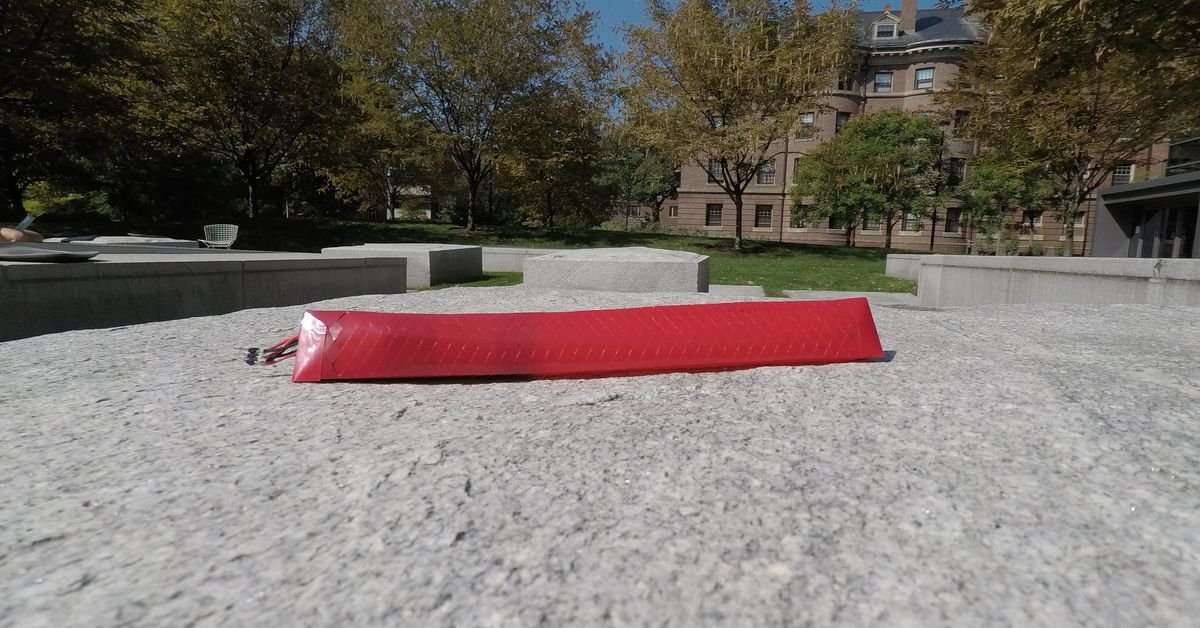The world is getting flooded with tiny (creepy) robots that can crawl all over the place, including your clothes. The latest one, created by scientists at Harvard University, uses artificial scaly skins to move forward — kind of like a snake.
The soft robot is just a silicone rubber tube. But what’s special about it is its skin — a thin, stretchable plastic sheet that’s been cut with a laser. The cuts, in the shape of triangles or circles, resemble the scales on the skin of snakes. When air is pumped into the tube, the robot expands and contracts, allowing the scales to pop up, anchor against the surface, and pull the robot forward. In a study published today in Science Robotics, scientists showed that the artificial snakeskins work against rough surfaces like asphalt and concrete. In the future, these robots could be scaled down and used to deliver drugs inside arteries, or in disaster situations where bots need to crawl inside narrow spaces.
Nature has inspired all kinds of robots before. Octopi have served as squishy muses many times, either because of their amazing camouflage or their wiggly shapes. Plants and salamanders have also played their part. The inspiration for today’s bots comes from snakes, which use scales on their skin to propel themselves. To mimic the snakeskin, Ahmad Rafsanjani, a postdoctoral researcher at Harvard University, resorted to the Japanese art of paper cutting, called kirigami. He used lasers to make cuts in thin plastic sheets in the shape of lines, triangles, circles, or trapezoids. The skins were then wrapped around silicone rubber tubes powered by air. (The air was either pumped through tubes, or thanks to a small control unit with onboard pump, battery, and sensors.)
The robot works this way: When the tube is inflated or deflated, it stretches forward, allowing the scales to pop up and then grab onto the surface. The friction generated in the process propels the bot forward (but not backward; the researchers are still trying to figure that out). The scaly skin is easy to make, and it saves engineers the pain of making actuators to enable movement. Rafsanjani and his colleagues also tried different scale shapes: the trapezoidal ones were the most effective, allowing for a longer stride.
The mechanics seem simple enough, but it actually took a year and a half to perfect the snake-y crawler. Rafsanjani made hundreds of skins and about 50 soft robots before it all worked out. “It takes a lot of design details to achieve such a simple motion,” he tells The Verge. The first prototypes just wouldn’t crawl: the tubes would expand upward or the skin was too thick. But finally, Rafsanjani and his colleagues were able to create just the right scaly skins to mimic snakes.
“It was very exciting,” he says. “It was a very happy moment.”

HouseSomalian on February 22nd, 2018 at 04:05 UTC »
Here's the main gif Another one Shape comparison Closeup
Cloudraa on February 22nd, 2018 at 02:57 UTC »
snek
n7-Jutsu on February 22nd, 2018 at 02:54 UTC »
I never seen a post this early on the front page before. I can't tell if it's a trap.